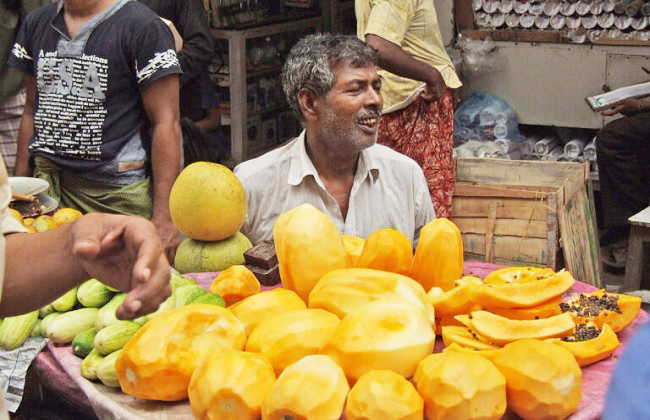
In the last few years in mid-western Bangladesh, the trend of planting different types of fruit orchards, like mango, lychee and papaya, has gone up in three districts together commonly known as the High Barind Tract — Rajshahi, Chapai Nawabganj and Naogaon.
“Transforming the land from rice and wheat fields to orchards is the easiest option for our livelihood because we do not get enough water to irrigate rice and other crops throughout the year. Moreover, orchards require limited water, but at the same time, they give us better profit,” said Raihan Kabir Ranju, a farmer from Nachole municipality, Chapai Nawabganj district, in western Bangladesh.
A study suggested that less water consumption, lower production costs, and higher turnover were the major reasons for transforming the land use in this part of the country.
As per the estimation by Bangladesh Rice Research Institute (BRRI), about 3,000 liters (790 gallons) of water is required to produce 1 kg (2.2 pounds) of boro rice, while wheat and maize require about 400 and 600 l (105 to 158 gal), respectively, for the same quantity.
However, for instance, Ranju said, “One acre of papaya orchard can require about one-tenth of the water that boro rice requires. Besides, it provides at least 50% more profit than rice.”
Consequently, many farmers have transformed their land from cereal croplands to orchards, ultimately impacting the country’s food production.
A study shows that Barind Tract, a region made up mostly of old alluvial soil, has been experiencing less vegetation and agricultural production due to depleted groundwater levels and gradually increasing temperatures.
According to the ministry of agriculture, the country produces about 46 million tons of cereal crops annually, including 39 million tons of rice, by cultivating around 8.8 million hectares (21.7 million acres) of arable land.
Boro makes up the largest fraction of rice at around 21 million tons, while aman and aush varieties contribute 15 and 3 million tons respectively.
According to the Bangladesh Bureau of Statistics (BBS), boro rice production increased in Rajshahi district from 96,000 tons to about 300,000 tons from the 1980-81 fiscal year to 2014-15 fiscal year.
Though there is no specific data on how much cereal cropland was transformed to fruit orchards in the region, the BBS data shows that boro rice production in Rajshahi district is gradually decreasing, from 265,300 tons in the 2020-21 fiscal year to 270,507 tons in the 2021-22 fiscal year.
Experts feared that, although the transition might bring secure cash crops for the farmers, this change could hamper the country’s overall food security.
“Cereal production will decrease as orchards occupy the arable land. Though the government is trying to retain cereal production by introducing high-yielding rice varieties, it will be tough to maintain the current volume of rice production as the arable land is shrinking to meet the demand of the rising population,” said Jiban Krishna Biswas, former director general of BRRI.
Groundwater depletion and shift in land use
Barind Tract, consisting of 16 northern districts of Rajshahi and Rangpur divisions, is a dry region compared to the rest of Bangladesh. At least two crops a year here are dependent on irrigation.
Three of the 16 districts, Rajshahi, Chapai Nawabganj and Naogaon, which get less rainfall than in other parts of the country, are tagged as High Barind Tract.
According to Bangladesh’s meteorological department, the average annual rainfall in the Barind area is about 1,542 millimeters (60.7 inches), while the country’s national average is 2,515 mm (99 in).
Considering the droughts in this part of the country, the government formed the Barind Multipurpose Development Authority (BMDA) in 1985. The agency has been supplying irrigation through groundwater extraction through about 16,000 deep tube wells in 7,770 square kilometers (3,000 square miles) of area.
Consequently, agricultural production, especially rice production in the dry zone, has increased by at least three times. However, the groundwater level has decreased significantly.
For instance, Bangladesh Water Development Board data says the groundwater table in the Nachole area of Chapai Nawabganj district dropped from 3.5 meters (11.5 feet) in 1980 to 25 m (82 ft.) in 2017.
Since 2013, BMDA started rationing irrigation initially in five sub-districts — Nachole, Tanore and Gomostapur of Chapai Nawabganj district; Godagari of Rajshahi district; and Porsha of Naogaon district — to prevent further decline of groundwater levels caused by existing practices of cultivating crops that consume high quantities of water, like boro rice.
Explaining the irrigation rationing, executive director of BMDA, Md. Abdur Rashid, said BMDA alternatively irrigates half of the total arable lands in the selected areas each year to prevent depleting groundwater levels.
He also said, “We assumed that the irrigation rationing would help the farmers to change the farming pattern towards crops that consume less water, like maize and different types of oil seed, from something that consumes more water, like boro. However, the farmers opted for orchards.”
(This article is republished from Mongabay under Creative Commons License)
Abu Siddique is Mongabay’s Contributing Editor for Bangladesh. He has worked for several of the leading national dailies including Dhaka Tribune, Daily Sun and The Business Standard, and has explored the remotest corners of the country in search of stories.

